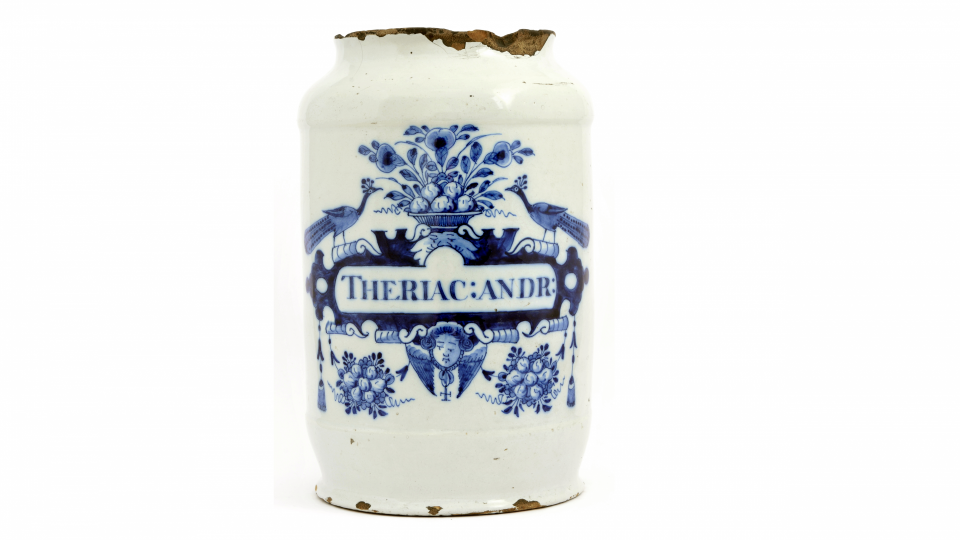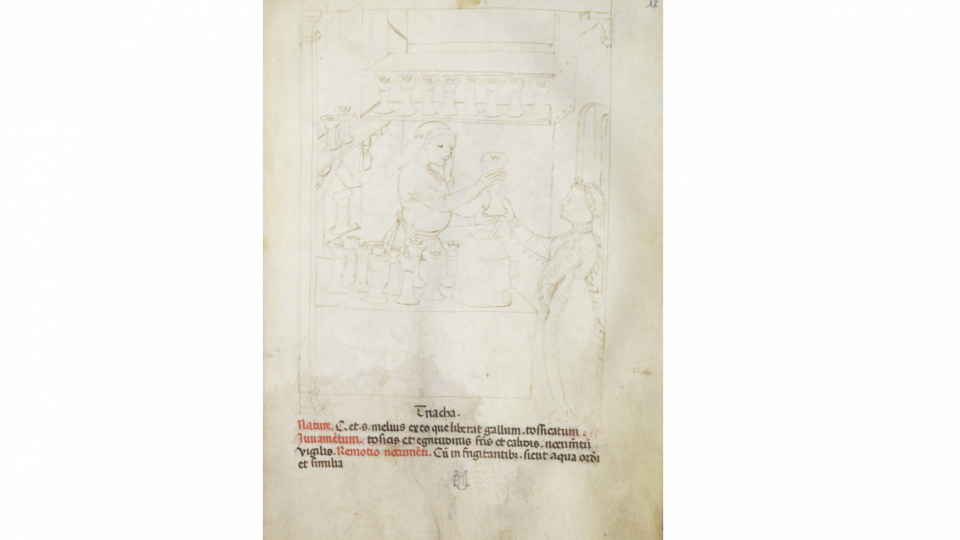Andromache's theriac




In the 18th century, the dispensary became a luxurious store imbued with a certain mystery. On the counters are placed scales, weights and mortars for spraying drugs, while the walls with carved shelves hold, bottles, vases, cans, boxes and pots decorated with Latin inscriptions and flowers, such as this Delft earthenware pharmacy jar. More precisely, it comes from the pharmacy of the former “Hôpital de Bavière”, an institution founded in 1602 by Prince-Bishop Ernest of Bavaria to provide care for the needy citizens of Liège.
The nursing staff was composed of "daughters of the Company of Mercy", who were to form a community of Augustinian hospitallers from 1626 onwards. In their duties, the nuns were in charge of the cleanliness of the patient's room and bed, took care of the food, prepared medication and maintained order. They acted as an intermediary between the patient and the doctor, while at the same time playing a spiritual role. In addition to the floral patterns and the two peacocks, the contents of the jar are indicated in its centre: this is the Andromache's theriac, also known as the great theriac. This noun is formed on the adjective thêriakos, meaning 'that which concerns venomous beasts'.
This name was first used by Nicandre de Colophon in the 2nd century BC. But history will remember the composition made by Nero's physician, Andromache (1st century) and popularized by Galen (2nd century), one of the Fathers of medicine. Andromache did not start from scratch; he took up an existing preparation, the Mithridateion, from the name of Mithridate VI Eupator (1st century BC), King of the Pontus, to which he added viper flesh. According to the notion of sympathetic therapy, it is the cause of the pain that provides the remedy. Vipers are therefore said to have an antidote in the body against their own venom, an antidote that is also effective against other poisons. The patient regains a new skin, like the snake that acquires a new skin during the moulting process. Galen specifies that if theriac is effective first against poisons and then against venoms, it is also effective against stomach aches, shortness of breath, intestinal disorders, jaundice or spasms.
Because of its many ingredients, the preparation took on a legendary and mysterious character in the Middle Ages. Teriacs enjoyed a significant rise in popularity in the Byzantine, Arab and Latin worlds. During the Renaissance and especially in the 17th century, sources about it multiply and its composition becomes more precise. This electuary (a soft drug made up of pulverized substances suspended in honey, syrup or resin) then consisted of about sixty medicinal substances, the main ones being viper flesh, beaver glands, cinnamon, pepper, nutmeg, saffron, myrrh, valerian and other plants such as scilla. This complete remedy is intended to ward off as many ailments as possible. It is mainly known for its anti-poisoning properties, but is also considered useful against colic, asthma, jaundice, bladder ulcers, urinary difficulties, kidney pain, and even plague and dysentery.
The difficulty in obtaining the ingredients makes theriac a valuable product, which counterfeiters try to imitate. The public authorities will gradually ensure that its trade, like that of other drugs, will be regulated more strictly by the apothecary profession. In the Liège region, it was not until the 14th century that the term apoticarius appeared in the sources, revealing the gradual distinction between the doctor, who reserved the diagnosis, prescription and monitoring of treatment, and the pharmacist, who devoted himself to the preparation of the drug. The apothecaries depended on the profession of the merciers, who had a market hall (destroyed in 1468). Theriac was already mentioned there as a remedy when the plague entered Liège in 1349-1350.
The first pharmaceutical regulations emanate from the Episcopal authority. The regulations given by John of Bavaria in 1414 and 1416 require "merchants, grocers and apothecaries" to sell their goods "good and fair" respecting weight and quality. In 1592, a new regulation of the guild was enacted and specified that no foreigner could open a pharmacy, nor sell theriac, poisons or drugs if he had not been visited and examined by the two masters of the guild. On 24 March 1699, Prince-Bishop Joseph-Clement of Bavaria promulgated a regulation ratifying the creation of the College of Physicians. For the first time in the history of Liège, doctors, surgeons and pharmacists were associated and depended on the same authority. The College now ensures the standardisation of knowledge, the control of practice, the fight against unlicensed practitioners and the settlement of disputes between doctors, apothecaries and surgeons.
Concerning apothecaries, it is henceforth forbidden for them to keep shop without the advice of the Collège. Their knowledge will be evaluated in Latin and they will have to prove that they have worked with a master for five years. They will also have to take a practical examination: the realization of a "masterpiece". The practising apothecary will have to strictly apply the prescriptions of the doctors, with particular attention to dangerous products: narcotics, violent purgative, mercurial, antimonials and vomiting.
The College will send two physicians and two apothecaries each year to examine the drugs, compounded and simple, and "no apothecary will be able to compound Theriac, Mitridate unless the ingredients, or simple ingredients that go into it, have been seen and examined by a few physicians to be sent by the College". The apothecaries will have to submit to it under penalty of having their dispensaries closed. In order to standardize the preparations, four doctors will be responsible for making an official pharmacopoeia (the students used to use their master's handwritten dispensary). The Pharmacopoea Leodiensis, was not completed until 1741. As emanation of the Prince, its use was made compulsory for all doctors and apothecaries in the country of Liège. It contains an authorised list of simple and compound drugs, i.e. galenical preparations, such as theriac, the price of which is henceforth fixed.
The precious nature of the preparation of theriac, especially since it should be left to rest for several years, makes its manufacture a rare and solemn event. In the 17th and 18th centuries, in order to show everyone the seriousness of this undertaking and the importance of this preparation, some apothecaries set up public demonstrations. In 1774, L.F. Desaive, an apothecary from Liège, was authorised by the Magistrate of the City to exhibit the ingredients of Teriac in the Town Hall. The announcement was made public by means of a placard. Desaive specifies that he does so for the benefit of the health of the citizens, with the aim of accuracy and emulation for the progress of the art of pharmacy.
At that time, however, theriacs no longer had a good reputation, as volume XVI of Diderot and D'Alembert's Encyclopedia shows. The author of the note on theriac considers it to be "one of the oldest and most famous compositions of pharmacy" whose composition has varied over time, but with restraint, because it is "a pharmaceutical monster" which is difficult to modify. The heap of "bizarre" drugs that "do not keep well" and whose virtues against venoms have been refuted, makes the author say that Andromache's theriac should be banned from the dispensary. The author prefers Diatessaron's theriac, also known as the theriac of the poor, because of the ease of its preparation and its low cost. It is a composition of four substances: gentian and aristolocha roots, bay laurel berries and myrrh, mixed with honey and juniper extract. According to the author, "it is not to be despised" and is very clean against poisons and various diseases.
At the same time, Tissot, one of the most famous physicians of the 18th century, published his Avis au peuple sur sa santé, a work published in the spirit of the Enlightenment and intended above all to be useful to the humankind. In his book, he also advises the theriac of the poor for malignant fevers in order to recover strength and restore digestion. For him, Andromache's Andromache Theriac is "of ridiculous composition", expensive and often dangerous. But it is true that the theriac of the poor does not make one sleep, because of the absence of opium.
Adulated by some, denounced by others, Andromache's theriac embodies a strong symbol for a pharmaceutical profession that defines itself around the defence of tradition and the exercise of complex empirical preparations. The preference for the diatessaron theriac in the 18th century underlines the conflict that existed at that time between polypharmacy and oligopharmacy, that is to say between defenders of complex and simple drugs.
More widely, the rejection of Andromache's theriac must be seen in the spirit of the Enlightenment and of triumphant reason, which, freed from superstition, aspires to place the condition of men at the centre of philosophical concerns. The medicine of the 18th century laid the foundations of the science of the following century, those of chemical analysis, inherited from the long research carried out to break away from the alchemical paradigm, of which Lavoisier, who published his Méthode de nomenclature chimique in 1787, was to be the most accomplished thinker. The strangeness of drug names contributed to discrediting the pharmacopoeia, which would change considerably in the 19th century thanks to the development of chemistry. More and more, complex and sometimes toxic plant drugs were replaced by the active ingredients they contained; aspirin was thus created in 1858. Experimentation on animals, and later on humans, led to a better understanding of the effects produced by medications. As a result, many miraculous remedies disappeared from the pharmacopoeia at the beginning of the 20th century, such as plaster, a preparation based on frogs, or theriacs.
Geoffrey Schoefs
Bibliography
-Angenot J.-F., La pharmacie et l'art de guérir au pays de Liège des origines à nos jours, Liège, Eugène Wahle, 1983.
-Boudon-Millot V., « Aux origines de la thériaque : la recette d’Andromaque », dans Revue d'histoire de la pharmacie, n° 367 (2010), p. 261-270.
-Chast F., « La thériaque à l’époque moderne. Chronique d’une fin annoncée du XVIe au XIXe siècle », dans Revue d'histoire de la pharmacie, n° 368 (2010), p. 493-510.
- De Bavière à la Citadelle, Liège, Massoz, 1980.
- de Louvrex M. G., Recueil contenant les édits et réglemens faits pour le Païs de Liège & comté de Looz, par les Evêques et Princes, tant en matière de police que de justice, nouv. éd. par Bauduin Hodin, t. III, Liège, Everard Kints, 1751, p. 46.
-Encyclopédie ou Dictionnaire raisonné des sciences des arts et des métiers, Neuchâtel, Samuel Faulcher, 1765.
- Havelange C., Les figures de la guérison, Paris, Les Belles Lettres, 1990.
- L’Esprit des journaux, t. XI, novembre 1775, p. 320
- Pharmacopoea Leodiensis, Liège, E. Kints, 1741.
- Schoefs G., « L’histoire de la médecine à Liège », dans La leçon d’anatomie, 500 ans de médecine à Liège, Liège, Nowfuture, 2017, p. 6-153.
- Tissot S. A., Avis au peuple sur sa santé, Lausanne, J. Zimmerli, 1761.
- Van Schoor O., « Une préparation publique de la thériaque à Liège en 1774 », dans Revue d'histoire de la pharmacie, n°88 (1934), p. 419-424.
- Flahaut J., « La thériaque diatessaron ou thériaque des pauvres », dans Revue d'histoire de la pharmacie, n°318 (1998), p. 173-182.
Photo captions :
- Pharmacy jar (photo n°01)
Delft earthenware - early 18th century - Hopital de Bavière (Liege) - Preserved in the Grand Curtius Museum
- Pharmacopoea Leodiensis (photo n°02)
E. Kints - 1741 - Liège - Preserved at the Bibliothèque Ulysse Capitaine
- Tacuinum Sanitatis (photo n°03)
Ibn Buṭlān - Italy - 14th century - f.37 recto - Preserved at the University of Liege
- The pharmacist (photo n°04)
P. Longhi - Oil on canvas - 18th century, Preserved at the Gallerie dell'accademia, Venice